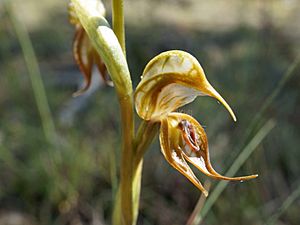Southern hooked rustyhood facts for kids
Quick facts for kids Southern hooked rustyhood |
|
|---|---|
 |
|
| Scientific classification | |
| Genus: |
Pterostylis
|
| Species: |
hamata
|
| Synonyms | |
|
Oligochaetochilus hamatus (Blackmore & Clemesha) Szlach. |
|
The Pterostylis hamata, also known as the southern hooked rustyhood, is a special kind of plant. It belongs to the orchid family and grows only in eastern Australia. This plant has a group of leaves that form a circle, called a rosette. It also has clear flowers with green and brown marks. Its labellum (a special part of the flower) looks like a thick, brown insect. The side parts of the flower, called sepals, are shaped like shallow dishes.
Contents
What Does the Southern Hooked Rustyhood Look Like?
The southern hooked rustyhood is a plant that grows from an underground part called a tuber. It comes back every year and loses its leaves in some seasons. At the bottom of its flowering stem, it has a rosette of six to fifteen egg-shaped leaves. Each leaf is about 2 to 3 centimeters (0.8 to 1.2 inches) long and 0.6 to 1.2 centimeters (0.2 to 0.5 inches) wide.
Flower Features
This orchid grows between two and twelve clear flowers. They have green and brown markings. Each flower is about 1.9 to 2.2 centimeters (0.7 to 0.9 inches) long and 0.7 to 0.8 centimeters (0.3 inches) wide. These flowers grow on a tall stem, which can be 20 to 40 centimeters (7.9 to 15.7 inches) high. There are also two to eight leaves wrapped around the stem.
The top sepal and the petals of the flower form a hood. This hood covers the central part of the flower. The top sepal has a thin, downward-pointing tip that is about 0.4 to 0.7 centimeters (0.16 to 0.28 inches) long. The side sepals point downwards and are joined together for about half their length. They are shaped like shallow dishes with their edges curving inwards. These side sepals then suddenly become very thin, like threads, about 1.2 to 1.5 centimeters (0.5 to 0.6 inches) long. These thread-like tips curve forward and have hooked ends.
The labellum is a special part of the flower that looks like an insect. It is brown, thick, and about 0.5 centimeters (0.2 inches) long and 0.2 centimeters (0.08 inches) wide. It has a groove and tiny bristles around its edges. The southern hooked rustyhood blooms from September to November.
How the Southern Hooked Rustyhood Got Its Name
The scientific name for this plant, Pterostylis hamata, was first officially written down in 1968. Two scientists, John Blackmore and Stephen Clemesha, described it. They found a sample of the plant near a place called Koorawatha. Their description was published in a magazine called The Orchadian.
The second part of its scientific name, hamata, comes from a Latin word. It means "hooked." This name fits the plant well because of the hooked tips on its side sepals.
Where the Southern Hooked Rustyhood Lives
The southern hooked rustyhood grows in the eastern part of New South Wales. You can also find it in the north-east corner of Victoria and in Queensland. It likes to grow in rocky areas within open forests.

